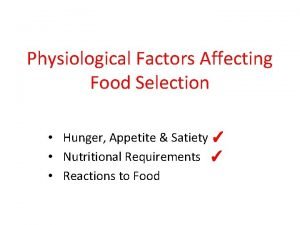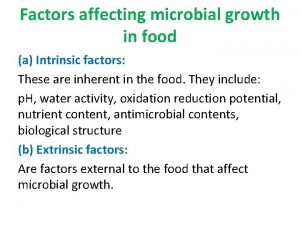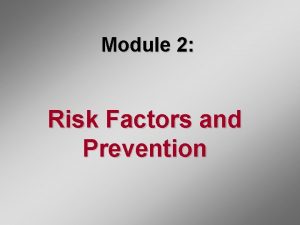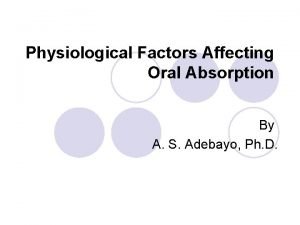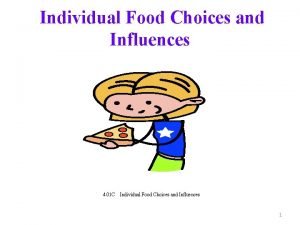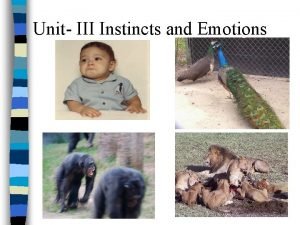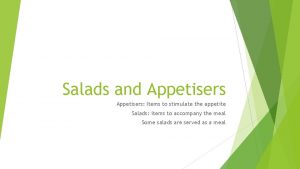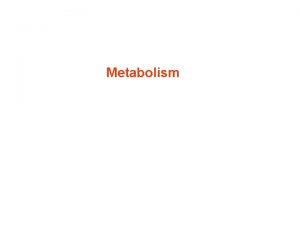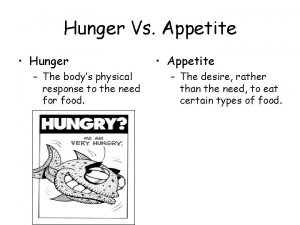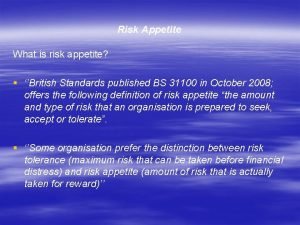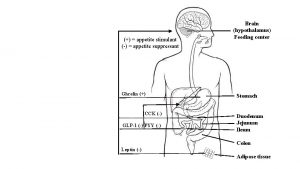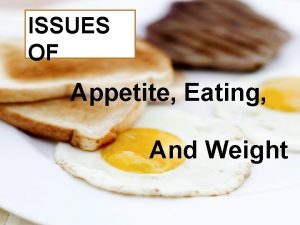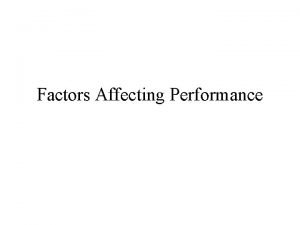Physiological Factors Affecting Food Selection Hunger Appetite Satiety


















- Slides: 18

Physiological Factors Affecting Food Selection • Hunger, Appetite & Satiety ✓ • Nutritional Requirements ✓ • Reactions to Food

Reactions to Food • Individuals select or reject food based on their reaction to the food’s physical appearance, its presentation, smell and texture. • Sensory Perceptions: using our senses to gauge and judge the quality and appeal of food. • Attractive colours and the creative arrangement of food stimulates the appetite and salivary glands.

Image: Burger Project, World Square. Jajo (2015). Image: La Mono, Merrylands. Jajo (2015)

Appearance Colour: • The colour of food indicates its quality and nutritional value. • Alterations in colour are one of the first signs of food spoilage. • Some colours rarely occur naturally in foods, so their use in manufactured foods is limited.

Image: Heinz introduced coloured ketchup. It did not last on the market for long.

EXPERIMENT: Sensory Reactions to Cupcakes Aim: To determine the effects of colour on the acceptability and appeal of food. Red, Vanilla, Green and Black coloured cupcakes were used to determine how colour influences food selection.

How does colour affect appetite? Image: White Rice with Grilled Chicken and White Sauce. Image: White Rice with Marinated, Roast Chicken topped with a garnish.

Shape: • The shape of food influences its appeal. Pictures in recipe books show important shape is in the presentation of a meal. • One of the recent innovations in the shape of food is the change in portion size for well-known products.


Turgor: • Turgor refers to the pressure placed on cell walls or membranes by fluids within the cell. • Turgor gives many foods a full, fresh appearance, a firm texture and crisp mouthfeel. • How does turgor influence food selection? Image: Fresh Capsicum. Very Turgid. Image: Wilted Capsicum. Non Turgid.

Textural differences in foods create interest in meals and stimulate the appetite. Image: Soft, fluffy rice with firm meat and crisp vegetables. Image: Crunchy, flakey short crust pastry with creamy custard filling and crisp berries. https: //www. youtube. com/watch? v=Ey. D 9_Ct 0 DIs

Flavour • Flavour is a sensory impression of food based on its taste and smell. • Our body uses taste sensors on the tongue to detect differences in flavour, with the help of the sense of smell. • The mouth contains 9000 to 10, 000 taste receptors, also known as ‘tastebuds’. Most are located on the tongue, others are located on the roof of the mouth and the back of the throat. • When you eat a particular food and the tastebud had been stimulated, the tastebud sends a nerve impulse to the brain, which registers that particular taste sensation.


Aroma • Aroma describes how something smells. In our nose there are odour receptor nerves that transmit signals to the hypothalamus in the brain. • Taste and aroma are related; many foods give off aromas that can be smelled before the food is eaten, as well as when the food is eaten. • Another word used to describe the smell of something is ‘odour’. Normally when we describe the food as having an odour, it indicates a lack of freshness. For example; sour milk.


Allergies A food allergy occurs when your immune system responds to a food it mistakenly believes is harmful. When the food is eaten, the immune system immediately releases antibodies in order to destroy the food. This reaction between the allergen and the antibodies causes the symptoms of the allergy, which can be dramatic and life threatening, even with only very tiny amounts of the allergen present.

• The reactions vary between individuals but may include abdominal swelling, vomiting, diarrhoea, itches and skin rashes, wheezing, headaches and disturbed sleep. • Common food allergens include; cow’s milk, shellfish, eggs, peanuts, wheat and soy.

On the other hand, a food intolerance occurs when the nerve endings in different parts of the body become irritated, causing symptoms such as; stomach & bowel troubles, headaches, swelling or hives. EXAMPLE: In people with coeliac disease (gluten intolerance) the immune system reacts abnormally to gluten (a protein found in wheat, rye, barley and oats), causing small bowel damage.
 What factors influence satiety?
What factors influence satiety? Describe a.l. washburn’s study.
Describe a.l. washburn’s study. Physical factors affecting sports performance
Physical factors affecting sports performance Factors affecting oxygenation
Factors affecting oxygenation Selection of site for bridge
Selection of site for bridge Pump selection factors
Pump selection factors A food or drink that stimulate the appetite
A food or drink that stimulate the appetite Factors affecting microbial growth in food
Factors affecting microbial growth in food Intrinsic factors affecting microbial growth in food
Intrinsic factors affecting microbial growth in food Factors affecting microbial growth in food
Factors affecting microbial growth in food Physiological factors in design
Physiological factors in design Module 2 physiological factors
Module 2 physiological factors Physiological factors
Physiological factors Cultural and situational factors that influence hunger
Cultural and situational factors that influence hunger Physiological influences on food choices include
Physiological influences on food choices include Spin selection rule
Spin selection rule Two factor theory of emotion
Two factor theory of emotion Salad that stimulate the appetite of your guest
Salad that stimulate the appetite of your guest Appetite approval ambition
Appetite approval ambition
